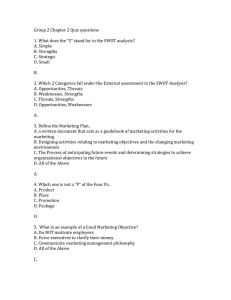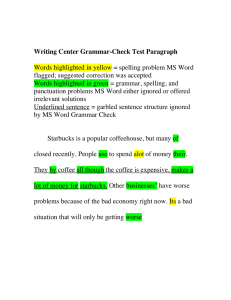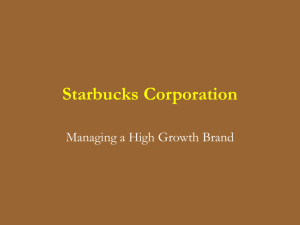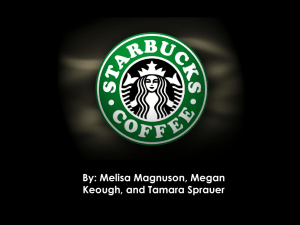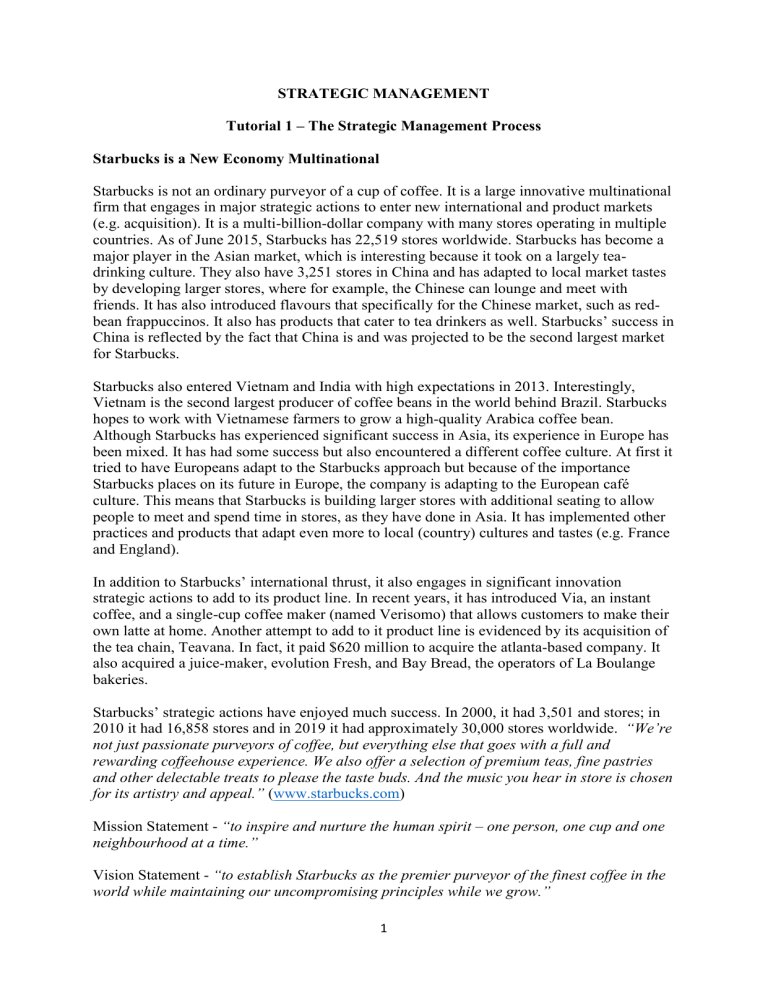
STRATEGIC MANAGEMENT Tutorial 1 – The Strategic Management Process Starbucks is a New Economy Multinational Starbucks is not an ordinary purveyor of a cup of coffee. It is a large innovative multinational firm that engages in major strategic actions to enter new international and product markets (e.g. acquisition). It is a multi-billion-dollar company with many stores operating in multiple countries. As of June 2015, Starbucks has 22,519 stores worldwide. Starbucks has become a major player in the Asian market, which is interesting because it took on a largely teadrinking culture. They also have 3,251 stores in China and has adapted to local market tastes by developing larger stores, where for example, the Chinese can lounge and meet with friends. It has also introduced flavours that specifically for the Chinese market, such as redbean frappuccinos. It also has products that cater to tea drinkers as well. Starbucks’ success in China is reflected by the fact that China is and was projected to be the second largest market for Starbucks. Starbucks also entered Vietnam and India with high expectations in 2013. Interestingly, Vietnam is the second largest producer of coffee beans in the world behind Brazil. Starbucks hopes to work with Vietnamese farmers to grow a high-quality Arabica coffee bean. Although Starbucks has experienced significant success in Asia, its experience in Europe has been mixed. It has had some success but also encountered a different coffee culture. At first it tried to have Europeans adapt to the Starbucks approach but because of the importance Starbucks places on its future in Europe, the company is adapting to the European café culture. This means that Starbucks is building larger stores with additional seating to allow people to meet and spend time in stores, as they have done in Asia. It has implemented other practices and products that adapt even more to local (country) cultures and tastes (e.g. France and England). In addition to Starbucks’ international thrust, it also engages in significant innovation strategic actions to add to its product line. In recent years, it has introduced Via, an instant coffee, and a single-cup coffee maker (named Verisomo) that allows customers to make their own latte at home. Another attempt to add to it product line is evidenced by its acquisition of the tea chain, Teavana. In fact, it paid $620 million to acquire the atlanta-based company. It also acquired a juice-maker, evolution Fresh, and Bay Bread, the operators of La Boulange bakeries. Starbucks’ strategic actions have enjoyed much success. In 2000, it had 3,501 and stores; in 2010 it had 16,858 stores and in 2019 it had approximately 30,000 stores worldwide. “We’re not just passionate purveyors of coffee, but everything else that goes with a full and rewarding coffeehouse experience. We also offer a selection of premium teas, fine pastries and other delectable treats to please the taste buds. And the music you hear in store is chosen for its artistry and appeal.” (www.starbucks.com) Mission Statement - “to inspire and nurture the human spirit – one person, one cup and one neighbourhood at a time.” Vision Statement - “to establish Starbucks as the premier purveyor of the finest coffee in the world while maintaining our uncompromising principles while we grow.” 1 Discussion Questions 1. Define the following terms: a. strategic competitiveness b. strategy c. competitive advantage d. above-average returns e. strategic management process? 2. What are the characteristics of the current competitive landscape? What two factors are the primary drivers of this landscape? 3. According to the I/O model, what should a firm do to earn above-average returns? 4. What does the resource-based model suggest a firm should do to earn above-average returns? 5. What are vision and mission? What is their value for the strategic management process? 6. What are stakeholders? How do the three primary stakeholder groups influence organizations? 7. How would you describe the work of strategic leaders? 8. What are the elements of the strategic management process? How are they interrelated? Multiple Choice Questions 1. A firm's ________ is defined as its theory about how to gain competitive advantages. a) objective b) mission c) vision d) strategy 2. A sequential set of analyses and choices that can increase the likelihood that a firm will choose a strategy that generates competitive advantages is the a) organizational change process. b) strategic management process. c) mission statement process. d) goal setting process. 3. A firm's ________ is its long-term purpose that defines both what it aspires to be in the long run and what it wants to avoid in the meantime. a) mission b) strategy c) objective d) goal 2 4. Actions firms take to gain competitive advantages in a single market or industry are known as a) business level strategies. b) corporate level strategies. c) diversification strategies. d) strategy implementation. 5. Actions firms take to gain competitive advantages by operating in multiple markets or industries simultaneously are known as a) corporate level strategies. b) diversification strategies. c) business level strategies. d) strategic alliance strategies. 6. ________ occurs when a firm adopts organizational policies and practices that are consistent with its strategy. a) strategy formulation b) strategic choice c) strategy implementation d) strategic control 7. When a firm is able to create more economic value than rival firms it is said to have a(n) a) comparative advantage. b) competitive advantage. c) residual advantage. d) economic advantage. 8. The economic interdependence among countries as reflected in the flow of goods, services, financial capital and knowledge across country borders is defined as a) hypercompetition. b) boundaryless retailing. c) strategic intensity. d) globalization. 9. The industrial organization (I/O) model argues that a) the key factor in success is choosing the correct industry in which to compete. b) the firm’s internal resources and capabilities represent the foundation for development of a value creating strategy. c) the key to earning above-average returns is strategic flexibility. d) the internal structure of the organization must match the industry in which it competes in order to earn above-average returns on investment. 10. The resource-based model of the firm argues that a) all resources have the potential to be the basis of sustainable competitive advantage. b) resources alone can be a source of sustainable competitive advantage. c) the key to competitive success is the structure of the industry in which the firm competes. d) resources that are valuable, rare, costly to imitate, and non-substitutable form the basis of a firm’s core competencies. 3

